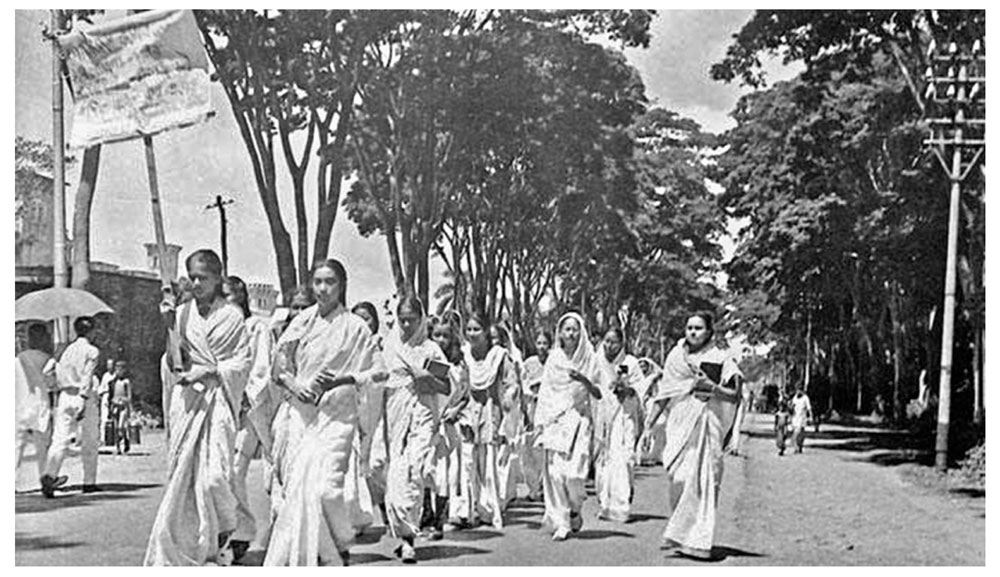Dr. Saleque Khan
The issue of establishing the Bangla language has a long history. The Muslims of undivided Bengal became the plurality by the end of the nineteenth century. The 1891 census of India found that the Muslims of Bengal formed 48.47% of the total population, while the Hindus accounted for 44.72%. The remaining 6.81% was formed by other religious groups. A greater percentage of the Muslim population consisted of poor peasants. A small percentage of the Muslim population belonged to middle economic class and upper class who liked to be called ashraf, meaning gentry or elite. The poor Muslim peasants were called atrap (non-ashraf), meaning ignoble. In the nineteenth and early twentieth centuries, Urdu was seen as the language of the ashraf, who were contemptuous of the Bangla language. There were a handful who, clinging to their status as ashraf, or desiring to be perceived as such, would continue to favour Urdu over Bangla, in order to associate themselves with the aristocracy of the Muslim rulers of North India and to maintain a distance from the common people’s language and culture — even though Islam does not permit class separation among Muslims. In 1882, Nawab Abdul Latif (also Luteef) of Faridpur said before the Hunter Commission (In late 1881 William Hunter was appointed to conduct an Education Commission in India), “Urdu was the mother tongue of the upper and middle class Muslims of Bengal while Bengali was spoken by the lower classes among them” (Anisuzzaman 2000). The end of the nineteenth century and the beginning of the twentieth century saw the emergence of a new Muslim middle class with a different view about language and culture.

From 1947 to 1951, the demand for Bangla to become a state language was mainly expressed through meetings, strikes, petitions and the exchange of opinions, though a few clashes occurred between the Bangla-speaking and Urdu-speaking populations. On 11 March 1948, under the auspices of the All Party State Language Committee of Action, a general strike was observed as a protest day throughout East Bengal. This was the first general strike in favour of the Bangla language. The party in power, Muslim League, used the police to suppress the protest. Students were beaten while they were protesting in front of the Secretariat, the High Court and other government buildings. Nearly a thousand people were thrown in prison. The leadership of Pakistan did not initiate a dialogue with the protesters who were mostly students and political and cultural activists. The new leaders of Pakistan, still thinking in a colonial mindset, failed to recognise the post-independence aspirations of the people of East Pakistan (Now Bangladesh). The Pakistani leaders in power did not acknowledge the passion of the Bangalees for their language and culture, and the strong feelings that were fuelling the move towards an increasingly secular and independent Bangla identity. The activities of the Bangla language movement peaked in 1952.
The struggle to make Bangla the official provincial language climaxed when students of Dhaka University marched in protest towards the Provincial Assembly House, defying Section 144 of the national law, a law that was introduced by the British rulers disallowing more than four people from congregating or marching together. The students were met by armed police who fired on them. The protesters who fell on the street became independent Pakistan’s first martyrs for Bangalee identity. In the context of dictatorship, Guy Debord observes, “The dictatorship of the bureaucratic economy cannot leave the exploited masses any significant margin of choice because it has to make all the choices itself, and because any choice made independently of it, even the most trivial — concerning food, say, or music — amounts to a declaration of war to the death on the bureaucracy. This dictatorship must therefore be attended by permanent violence” (Debord 1995).
The rulers of Pakistan did not allow people of East Bengal to choose Bangla over Urdu, and met the protesters on the streets with state violence. The space adjacent to the main street in front of Dhaka Medical College where Abul Barkat fell became the performance space for both mourning and protest. On the very day of Abdul Barkat’s murder (two other martyrs fell in a different location), a temporary structure was built and given the name Shaheed Minar (the martyrs minaret). Later a permanent monument was built and 21 February was named Shaheed Dibosh (Martyrs Day), although the other martyrs (beside the first three martyrs of 21 February) fell on subsequent days and in different nearby locations. Now the Ekushey February, Shaheed Dibosh is observed as International Mother Language Day and continues to display the asseveration of Bangalee identity on the streets – the performance space of Bangladesh.
____________________________________________
The writer is a faculty member, South Asian Media Institute, Pathshala, Dhaka

